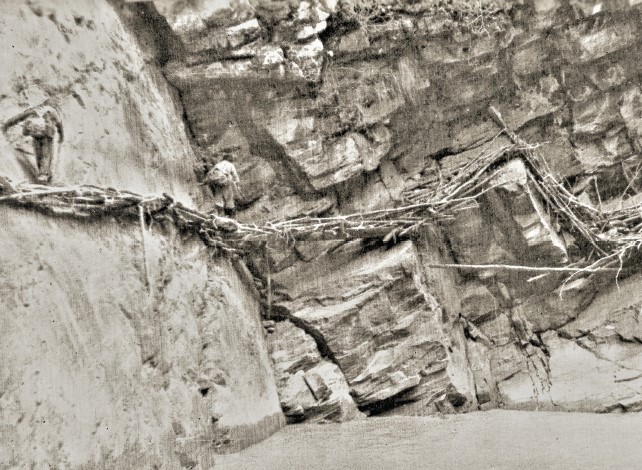
Ever cross a ‘parri’? Here’s your chance, vicariously.
I’ve had fun recently perusing mountaineering books dating back over half a century looking for dangerous river walks. Wow, what travelers in Nepal’s outback went up, across, around, over, and through in the early days of trekking. Some of them wore hob-nailed boots and carried clumsy wood-frame-and-canvas backpacks. But that was nothing compared to the obstacles they faced, often scared and befuddled, on trails through roaring river gorges.
Consider what climbers on the 1954 British Expedition to Baudha Himal faced while trekking along the Buddhi Gandaki River. It was there, well below the peak, that they encountered a particularly spectacular bamboo ‘parri’ across a cliff face. Their account describes traversing one spectacular stretch “Where the rock walls of the gorge fall vertically” blocking passage. Then, either “the track goes under water and one wades downstream; or it climbs a thousand feet to avoid the obstacle; or it is built out on catwalks of dilapidated bamboo on the walls themselves.”
They describe these “incredibly gimcrack” catwalks, or gangways ? known locally ‘parris’ ? as fearful to traverse. “Miscellaneous bits of wood and bamboo splinters formed the hammock-like ‘pathway’, tied together with rotting pieces of twine,” we read in ‘The Moated Mountain’ (1955). One of the Brits noticed “with more than a little trepidation” that the knots used to bind the ‘parris’ were granny knots, a derisive term for reef-knots (or square-knots) tied the wrong way, making them exceptionally insecure. But then they noticed that “the material forming the footing was probably as likely to give away as the knots.” In either case, “Directly beneath these shattered contraptions the grey glacier-torrent swirled along, ... mercilessly swift. If a man once fell into its smooth cold grasp there would be no hope whatever of saving him.”
Where the parri was absent, the traveler faced the bare cliff and either waded “up to his neck” in the river, or would “claw his way desperately along the hanging rock,” or performed an acrobatic “fly-crawl along an outward-sloping ledge overhanging the torrent.”
In short, bamboo parris were treacherous. But, so were those made of wooden planks.
In 1950, H.W. ‘Bill’ Tilman and party crossed a particularly dangerous plank ‘parri’, deep down in the Marsyangdi River gorge on the Manang trail. Today’s modern travelers have the option of going up and down this route by bus, jeep or motorcycle, or by walking, either on the road or by an alternate route opened by the Annapurna Conservation Area Project (ACAP). But in 1950 there were no such options, nor were there in the 1960s when I first trekked this way.
In his classic ‘Nepal Himalaya’ (1952), Tilman describes the Marsyangdi River parris as wooden galleries “seldom wider than a single plank ... reached by a stone staircase or up-ended logs with footholds cut in them. When the river was low many of these cat-walks could be avoided by a little boulder-hopping in the riverbed. In the rains the traveler has no choice. He must then mind his step, for the planks are greasy with rain or with spray from the surging river.”
Sometimes they had particularly frail handrails, “better left alone or at the most touched rather than grasped. The track, slimy, slippery and half overgrown after months of rain, presented the unwary with many opportunities for misadventure. One had to shuffle very quietly over the narrow planks of the ‘parris’ which were greasy enough to warrant the strewing of a little sand for those misguided enough to wear rubber-soled boots.”
Be grateful today that most of Nepal’s wild river crossings have safe modern steel bridges. In my minds eye, however, I see myself in something like an old vaudeville filmstrip close to slipping off one of those gimcrack gangways into the roaring river.
Photo from ‘The Moated Mountain’ by Showell Styles (1955). Read more about the 1954 Baudha Himal expedition in ‘The View from Sirandanda’ at page __ in this issue of ECS Nepal. The author can be reached at don.editor@gmail.com










